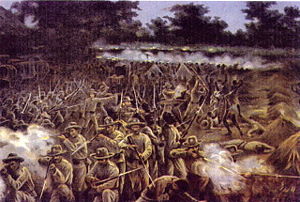Battle of Marracuene
This article needs additional citations for verification. (September 2024) |
| Battle of Marracuene | |||||||
|---|---|---|---|---|---|---|---|
| Part of Campaigns of Pacification and Occupation | |||||||
 Marracuene at war. 1899. | |||||||
| |||||||
| Belligerents | |||||||
|
| Ronga forces | ||||||
| Commanders and leaders | |||||||
|
| nuã-Matidjuana caZixaxa iMpfumo | ||||||
| Strength | |||||||
|
800 soldiers 37 officers | 4000 men | ||||||
| Casualties and losses | |||||||
|
24 dead 28 injured | 66 dead | ||||||
The Battle of Marracuene was a military confrontation that took place on February 2, 1895, near Marracuene, Mozambique, between Ronga forces commanded by the young prince Roberto Zichacha and Portuguese forces commanded by Major Alfredo Augusto Caldas Xavier. The battle took place in the context of Portuguese colonial operations, at the time referred to as the Campaigns of Pacification and Occupation.[1]
History
[edit]At the end of January 1895, a Portuguese force, commanded by Major José Ribeiro Júnior and Alfredo Augusto Caldas Xavier, advanced towards Marracuene, on the right bank of the Komati River. Due to the illness of Major José Ribeiro Júnior, the force was effectively commanded by Major Caldas Xavier, who was almost solely responsible for conducting the operations. The expedition included 37 officers and 800 soldiers.
The Ronga forces, totaling around 4000 men, were commanded by the young Ronga prince "nuã-Matidjuana caZixaxa iMpfumo", who would become known in Portuguese historiography as Zichacha, and who would be, a year later, one of the prisoners deported to the Azores. The chief of Moamba had already allied himself with the Portuguese and only Matibejana and Mahazul fought.
Upon approaching the location, the Portuguese military forces, which included the indigenous squares of Angola and of Mozambique, entrenched themselves in a military square and prepared for combat. The confrontation took place in the early hours of February 2, 1895. The Portuguese force, used their cannons and machine guns in order to overpower their enemy and managed to repel the assaults of the Ronga forces, who twice broke through the square, with enormous bravery on both sides.
In the end, the superiority of western firearms was crucial to the victory of the Portuguese troops. Around 66 Ronga warriors were found dead. According to the combat report, the dead at the site were buried and the wounded were disposed of in piles and cremated with petroleum, leaving a nauseating smell in the air. On the Portuguese side, 24 deaths and 28 injuries were recorded.
Days later, the Portuguese withdrew to Lourenço Marques, while the Ronga forces reorganized around Magude, where the rulers Nwamatibyane and Amgundjuana took refuge, coming under the protection of Gungunhana who accepted their vassalage. Mahazul did not fight in Marracuene, just as he had refused to participate in the attack on Lourenço Marques.
The battle of Marracuene is today sometimes referred to in Mozambique as "Gwaza Muthine", an expression in the Ronga language that means "lugar do trespasse com a lança".
See also
[edit]References
[edit]- ^ "História de Moçambique - Formação e oposição", René Pélissier, Editorial Estampa, 3.ª Edição, Lisboa, 2000, Volume II, pp. 273
